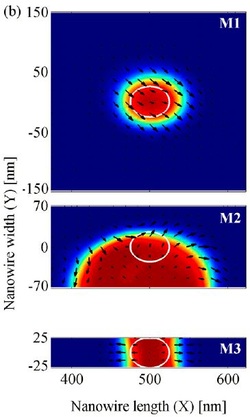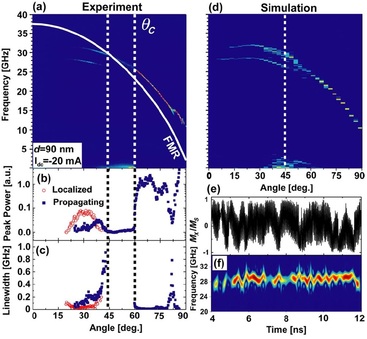|
Celebrating the publication of Ezio's Phys. Rev. Lett., 112, 047201 (2014). Happy times and very tasty burgers at Butcher's Market! From left to right: Afshin, Randy, Johan, Yuli, Ezio, Masoumeh and Philipp.
0 Comments
 This analytical and numerical work builds on our previous experimental demonstration of magnetic droplet solitons [Science 339, 1295 (2013)] where we confirmed the predictions by Ivanov and Kosevich from over 35 years ago [Zh. Eksp. Teor. Fiz. 72, 2000 (1977)] and the more recent predictions by Hoefer, Silva and Keller [Phys. Rev. B 82, 054432 (2010)]. Droplets form naturally in systems with attractive forces. Water droplets are e.g. formed from the attractive polar interactions between water molecules. In ultrathin magnetic films the so-called perpendicular magnetic anisotropy (PMA) can create an attraction between spin wave excitations (magnons) and if a sufficient number of magnons are present in a region (analogous to a sufficient number of water molecules) they can condense into a magnetic droplet soliton. Much like water on extended surfaces, droplets are easily formed in extended PMA layers. However, the nucleation in a narrow channel is not easily predicted. In this paper, we show by numerical simulations that magnetic droplets can indeed be excited in nanowires and in doing so can acquire two novel forms: an edge and a quasi-one-dimensional (Q1D) nanowire mode. The edge mode arises as the physical boundaries attract the droplet the same way as a water drop would be attracted by a neighboring polar surface, e.g. a piece of glass. On the other hand, the Q1D exists in very narrow wires, where both boundaries attract the droplet. As a result, the Q1D acquires an additional property known as chirality which is a well-defined magnetic state that makes it especially resistant to disturbances. Due to these characteristics, such novel droplet modes can be identified by their intrinsically different frequency. Our simulations suggest means to experimentally prepare and observe these modes for their detailed physical study and in the prospect of nanoscopic applications for data storage. E. Iacocca, R.K. Dumas, L. Bookman, S.M. Mohseni, S. Chung, M. Hoefer, and J. Åkerman, Con fined dissipative droplet solitons in spin-valve nanowires with perpendicular magnetic anisotropy, Phys. Rev. Lett. 112, 047201 (2014).  It has been argued that if multiple spin wave modes are competing for the same centrally located energy source, as in a nanocontact spin torque oscillator, that only one mode should survive in the steady state. Here, the experimental conditions necessary for mode coexistence are explored. Mode coexistence is facilitated by the local field asymmetries induced by the spatially inhomogeneous Oersted field, which leads to a physical separation of the modes, and is further promoted by spin wave localization at reduced applied field angles. Finally, both simulation and experiment reveal a low frequency signal consistent with the intermodulation of two coexistent modes. Randy K. Dumas, E. Iacocca, S. Bonetti, S. R. Sani, S. M. Mohseni, A. Eklund, J. Persson, O. Heinonen, and Johan Åkerman, Spin-Wave-Mode Coexistence on the Nanoscale: A Consequence of the Oersted-Field-Induced Asymmetric Energy Landscape, PRL 110, 257202 (2013). |
Archives
January 2016
Categories
All
|

 RSS Feed
RSS Feed